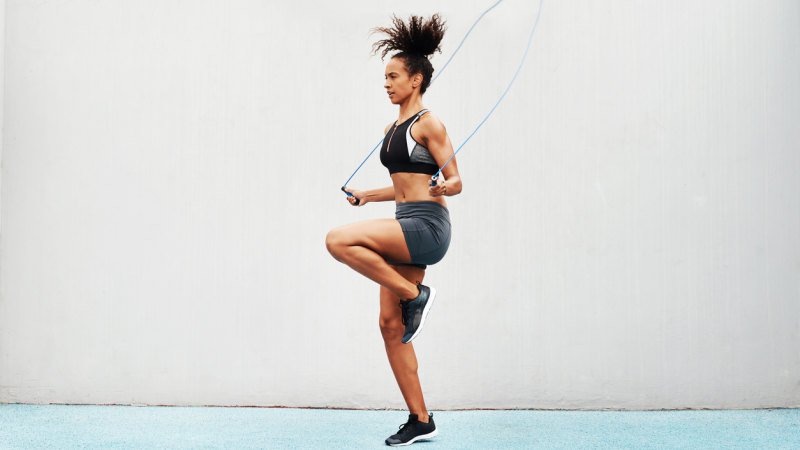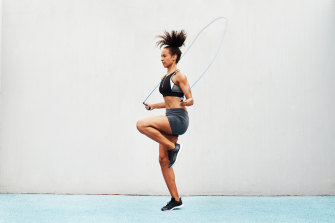A young woman recently signed up at the club where I work as a fitness instructor. She was new to exercise and, after a few weeks, confessed to me that she’d put off joining for ages because she’d expected the workouts to demand lots of jumping – something she’s keen to avoid because of bad ankles and knees, and she hasn’t “lost the COVID kilos yet”.
Once she’d started training, she quickly learned something: jumping in exercise is entirely optional. Every exercise can be adapted to be easier on the joints. It’s a myth that you have to punish your body in a workout to gain anything from it.
“Fitness is the longest of long games. This is an investment plan,” says Kieran Maguire, an advocate of low-impact strength training. Credit:iStock
The technical term for exercise that significantly increases the load on your joints is high-impact – and you might not realise quite how high that impact is. According to exercise scientist Kieran Maguire, director of Science of Fitness, running can put a load of up to seven times your bodyweight on your knee joints. “That’s a lot of mass to absorb,” he says. No wonder your knees always ache after that first run.
There are plenty of good reasons to avoid high-impact exercise: pre-existing injury, fear of new injury, being overweight, uncertainty about unfamiliar movements, feeling uncoordinated or unfit, disability, muscle soreness, age or low bone density. Or maybe you exercise in an apartment where you can’t jump around and disturb your neighbours. And maybe you just don’t feel like jumping today.
Women may have additional reasons including period pain, endometriosis, pregnancy and postpartum pelvic floor issues.
The good news is that even if high-impact exercise isn’t for you, that doesn’t mean you can’t earn the many health benefits of high-intensity exercise. “Impact and intensity are two separate things,” says Amelia Phillips, fitness expert and host of the podcast Healthy Her. “You can have a really high-intensity workout that’s low impact.”
“The rower is a great example of equipment that you can put a beginner and an Olympian together for two minutes and they’ll both have the same intensity workout.”
Low-impact, high-intensity exercise that puts less stress on joints includes cycling on a stationary bike, swimming or using a cross-trainer or rowing machine.
“The rower is a great example of equipment that you can put a beginner and an Olympian together for two minutes and they’ll both have the same intensity workout,” Phillips says. That’s because exercise intensity is entirely relative to each person’s individual fitness and experience.
Both Maguire and Philips emphasise that any exercise can be adapted to reduce – or increase – its impact. For example, jumping squats can be regressed to bodyweight squats. Mountain climbers, the exercise where you start in a high plank position then pull one knee at a time to your chest, can be adapted so that you tap your feet forward instead of sprint in place.
Even the notorious burpee, an exercise regarded as only for the very fit, can be tamed: instead of jumping then hurling your body to the ground, squat and place your hands on the floor at a pace that challenges you, step back to a push-up position, add an optional push-up from your toes or knees, then reverse till you’re standing upright again.
Phillips explains burpees build fitness effectively because they force blood to shunt rapidly between the upper and lower body, an effect that still occurs in the lower-impact version. (So sadly, there is no escape from burpees.)
Stick to trainers or exercise programs that tailor workouts to you. Les Mills classes, a staple of the fitness industry, have long offered low-impact variations to allow participants of all ability levels to train side-by-side, while newer workout apps such as Kayla Itsines’s Sweat and Apple’s Fitness+ respectively include “no jumping” workouts and gentler modifications for each exercise.
Maguire also suggests starting out with strength training, ideally guided by a coach or personal trainer, as a path to more advanced forms of exercise. “Building strength sets us up to be able to handle the stress and the load of high impact,” he says.
And if you’re new or returning to exercise, you don’t need to aim for high impact or high intensity – just aim to keep moving. “One session a week is 100 per cent better than zero. Start with the basics and do them really well,” Maguire suggests. “Fitness is the longest of long games. This is an investment plan.”
Make the most of your health, relationships, fitness and nutrition with our Live Well newsletter. Get it in your inbox every Monday.
Most Viewed in Lifestyle
From our partners
Source: Read Full Article

